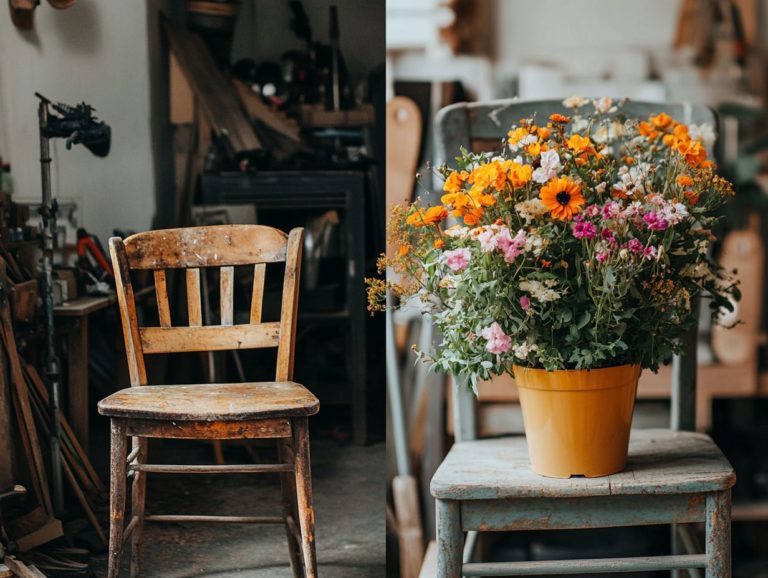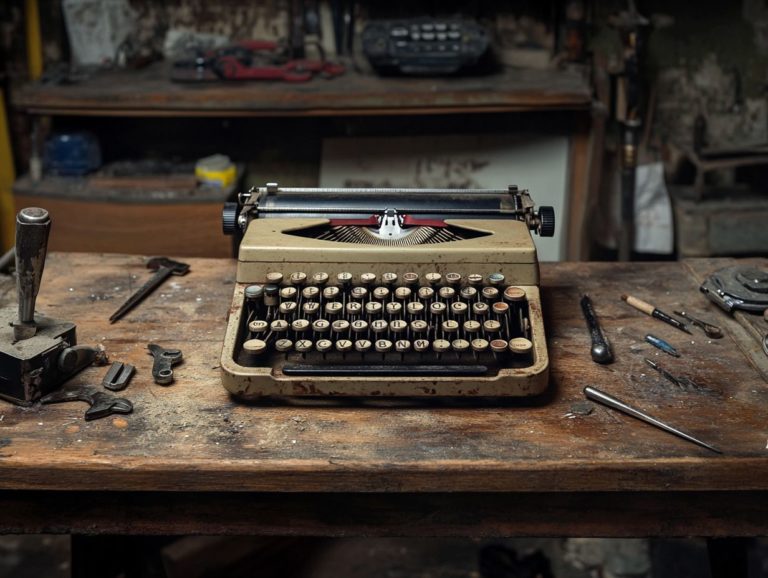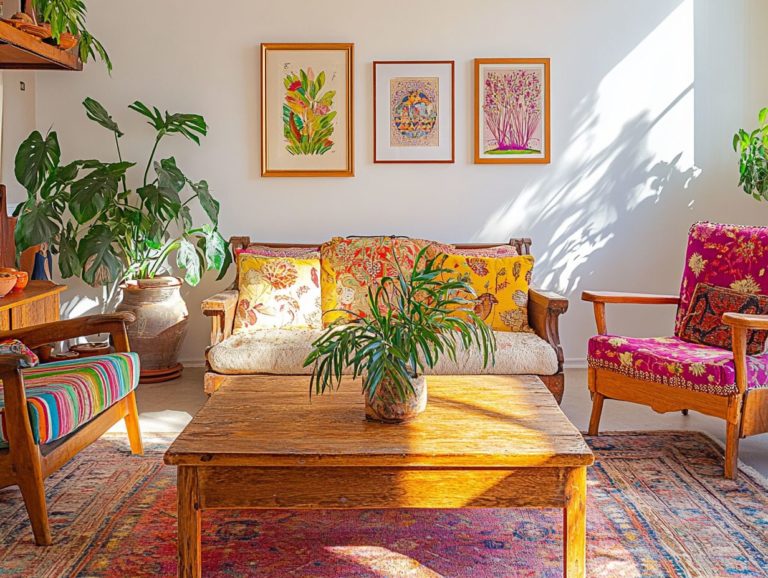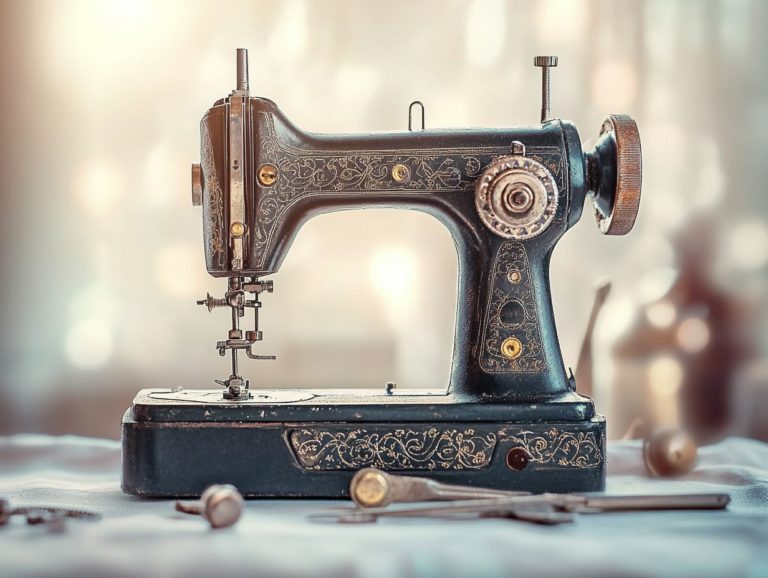Restoring Vintage Wood: Techniques You Need
Restoring vintage wood furniture, including antique furniture, offers an opportunity to revitalize cherished pieces. This enables them to shine in contemporary settings while honoring their distinctive history.
This guide will walk you through the various types of wood typically found in vintage furniture. You will learn how to identify common damages and prepare for the restoration process, including effective woodworm treatment.
Discover the essential tools and techniques you need today! You ll find expert tips for applying wax and finishing, as well as protecting your restored wood to ensure its beauty endures for years to come.
Jump right in and discover the secrets of vintage wood restoration, along with valuable cleaning tips!
Contents
- Key Takeaways:
- Understanding Vintage Wood
- Common Issues with Vintage Wood
- Preparing for Restoration
- Restoration Techniques
- Finishing and Protecting Vintage Wood
- Frequently Asked Questions
- What types of techniques are needed to restore antique wood?
- Is sanding necessary when restoring vintage wood?
- Can I use any type of stain when restoring vintage wood?
- What is the best way to remove old paint or varnish from vintage wood?
- How do I know if a vintage wood piece is worth restoring?
- Can I restore vintage wood on my own or should I hire a professional?
Key Takeaways:

Understanding Vintage Wood
Grasping the nuances of vintage wood is essential for anyone diving into antique furniture restoration. This knowledge encompasses the diverse types of wood used in furniture crafting, their distinctive characteristics, and how they age gracefully over time.
Vintage wood, especially European oak, boasts unique traits that enhance both its visual appeal and its structural integrity. Understanding how to care for these woods is crucial for preserving the beauty and longevity of antique pieces.
Applying a top-quality wax finish and using wood glue are critical elements of any restoration project.
Types of Wood Used in Vintage Furniture
Vintage furniture often showcases a delightful array of woods, each with its own distinct qualities and charm. Premium options like European oak and teak stand out for their exceptional characteristics.
European oak is celebrated for its strength and remarkable resistance to wear, making it a top choice for collectors. Teak has natural oils that provide exceptional resilience against moisture, rendering it perfect for both indoor and outdoor settings.
In terms of restoration, these woods respond beautifully to careful refinishing methods. By employing proper care methods such as avoiding direct sunlight and using appropriate polishes you can significantly enhance the longevity of vintage pieces.
This not only preserves their historical character but also accentuates their inherent beauty.
Common Issues with Vintage Wood
Vintage wood often comes with a host of common issues that demand your attention for a successful restoration. You may encounter woodworm infestations, unsightly water marks, and surface scratches that can detract from the charm of antique furniture.
Recognizing these challenges is crucial to restoring these pieces to their former glory. Prompt intervention is key to preventing further damage.
Treatment options are varied, from effective woodworm treatment solutions to methods for eliminating deep scratches and tackling those pesky water marks. This ensures that each vintage treasure retains its value and elegance.
Start your restoration journey now and bring your vintage pieces back to life!
Identifying Damage and Wear
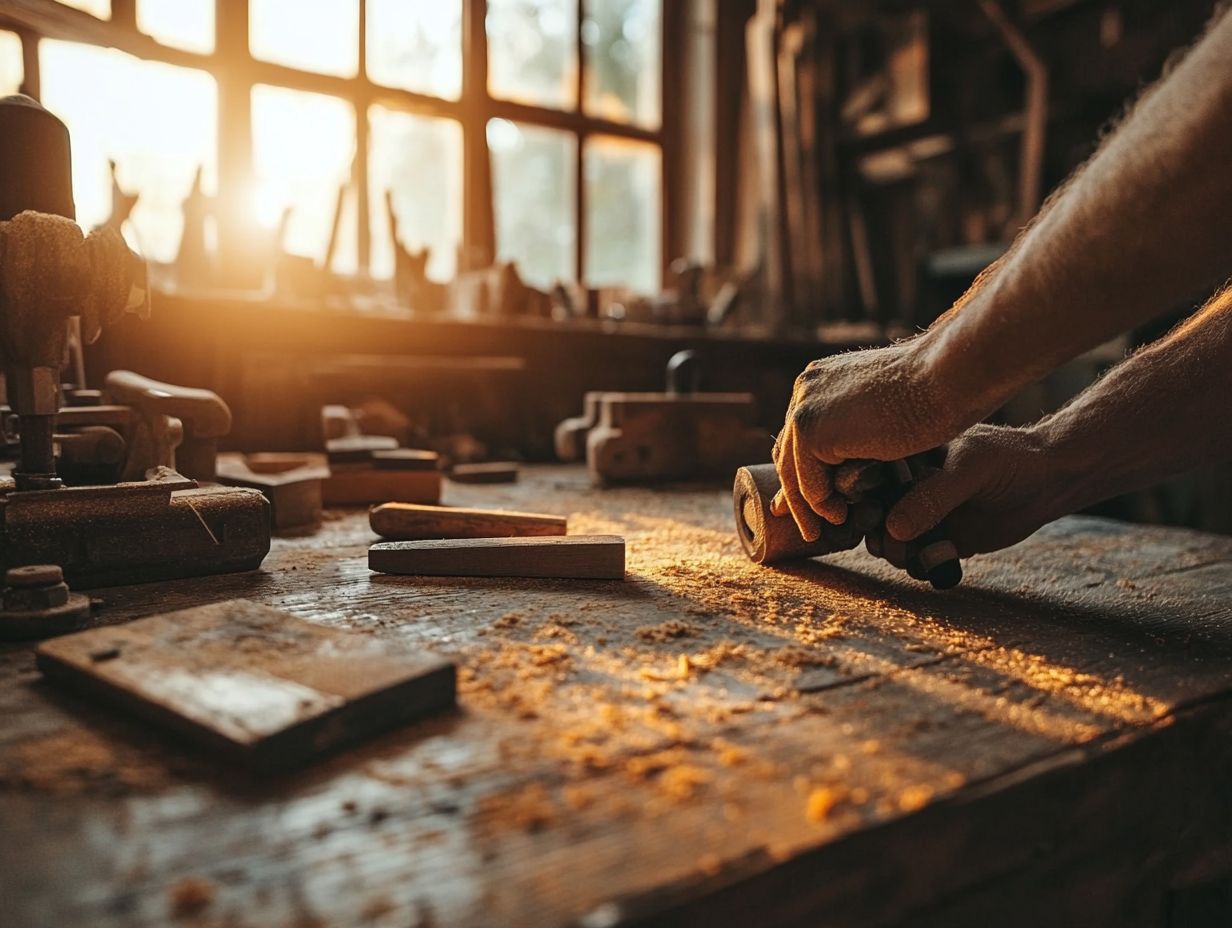
Identifying damage and wear in vintage wood is a crucial first step in your restoration journey. This assessment allows you to apply appropriate treatments, whether you re dealing with woodworm, deep scratches, or surface scratches.
As you evaluate the condition of vintage wood, keep an eye out for specific signs that may indicate deeper issues. For example, a powdery residue could mean a woodworm infestation, which can significantly compromise the structural integrity if left unaddressed.
Signs of water damage like discoloration or warped surfaces demand your immediate attention. These issues prompt a thorough inspection and potential application of Repair King Wax.
Visible scratches and dents, while more superficial, can still impact the overall aesthetic. They deserve a spot on your priority list during the restoration process. By systematically evaluating these elements, you can effectively plan the restoration and address the most critical issues first to preserve that charming vintage allure and ensure the wood’s longevity. For those looking to enhance their skills, check out these DIY staining and finishing tips for vintage furniture.
Preparing for Restoration
Getting ready is essential! Gather your essential tools and materials, such as wood glue, soft cloths, and specific products that work best, like Howard s Restor-A-Finish, ensuring a smooth and successful process.
Proper preparation lays the foundation for effectively addressing typical issues encountered in vintage wood. This significantly enhances the quality of the final result. With the right equipment at your fingertips, you can confidently tackle challenges such as scratches, water marks, and overall wood care. Additionally, for those looking to restore fabrics, considering the best vintage fabric restoration techniques can help rejuvenate that antique furniture to its former glory.
Essential Tools and Materials
Essential tools and materials for vintage wood restoration include a variety of items, such as polishing cloths, wax finishes, and cleaning products. These are all designed to effectively revive the beauty of your antique furniture.
These tools are crucial for ensuring a successful restoration process. Soft, lint-free cloths are critical when applying finishes like furniture wax, as they prevent scratches while enhancing that coveted shine. Furniture wax, specifically formulated for antiques, not only protects the wood but also nourishes it, revealing the rich depth of its grain.
In terms of cleaning, consider gentle solutions like a mixture of mild soap and water, which will remove dirt without damaging the finish.
- Howard s Feed and Wax
- High-quality beeswax for a stunning luster
- Microfiber cloths to maintain the impeccable condition of your restored pieces.
Each of these items serves a unique purpose, contributing to the overall longevity and visual appeal of your cherished vintage furniture, while polishing reviver enhances that aesthetic.
Restoration Techniques
Restoration techniques for vintage wood can differ significantly, yet some key methods stand out. You might consider applying wax finishes, utilizing liquid sanding a method that helps smooth the wood surface for surface preparation, and using products like Repair King Wax and teak oil to tackle imperfections.
Each of these techniques is crucial in bringing back the original beauty and functionality of antique furniture. Understanding these methods is essential for anyone engaged in the restoration process, giving you the power to select the most suitable technique based on the specific needs of the wood.
Start your restoration journey with confidence and watch your antique pieces come back to life!
Step-by-Step Restoration Process
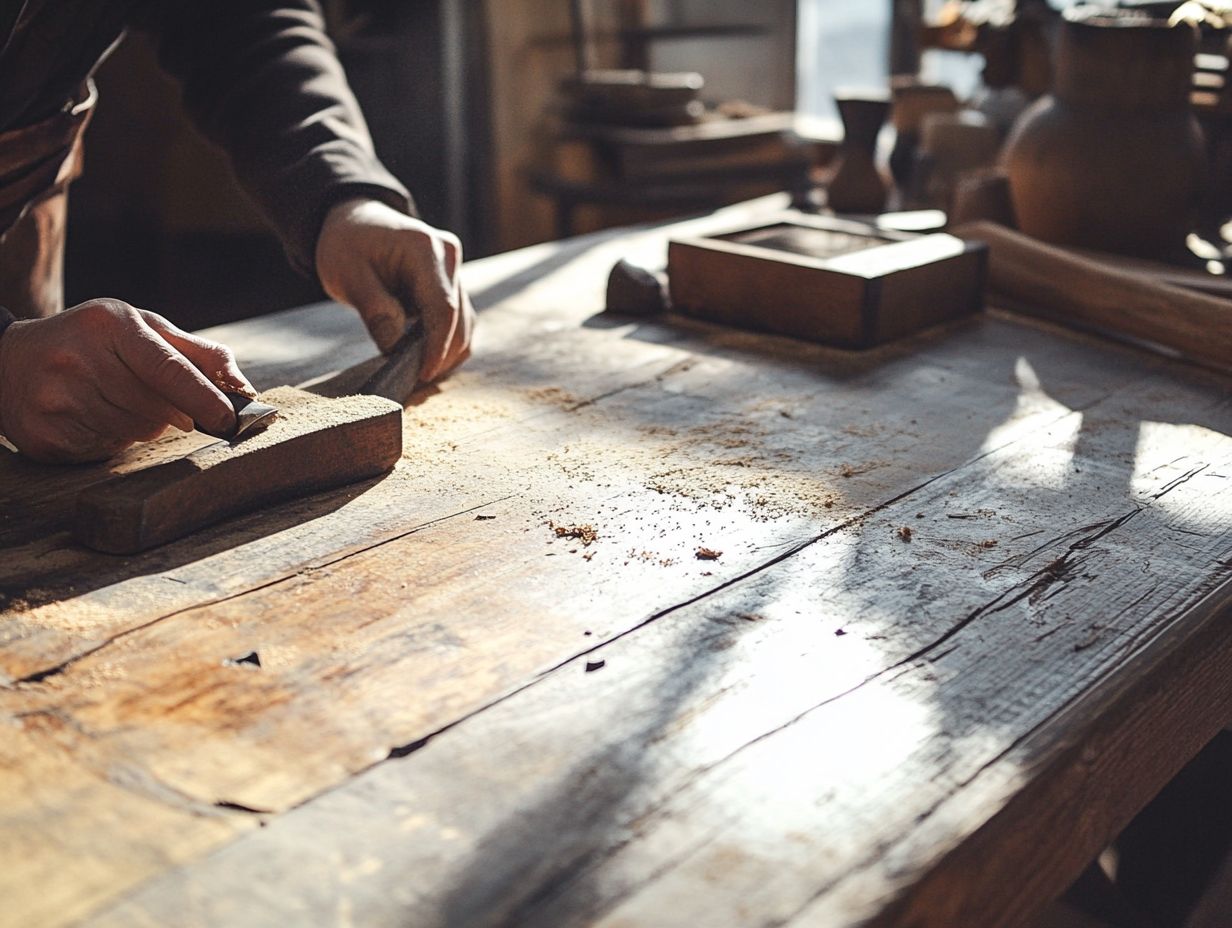
The step-by-step restoration process consists of several key actions, including surface cleaning, wax application, and reviving dullness to bring back the original beauty of your antique furniture.
This guide walks you through each stage. Follow along for effective restoration. Begin with cleaning; it s essential to choose the right products that won t damage the wood.
Once that s done, applying a quality wax will not only enhance the shine but also provide a protective layer for the surface.
Next, focus on addressing any dullness. Use fine steel wool or a soft cloth to buff out scratches and restore the piece s luster. Test products in inconspicuous areas and avoid excess water, which can warp the wood.
Steering clear of common mistakes like using abrasive cleaners or skipping the drying time between layers is crucial to maintaining the quality of your restoration.
Finishing and Protecting Vintage Wood
Protecting vintage wood is key! It keeps your cherished pieces beautiful and lasting. You can achieve this by using top-notch options like furniture wax, brass polish, and teak oil.
These choices will enhance the wood’s natural charm and ensure its enduring appeal for years to come.
Choosing the Right Finish
Choosing the right finish for vintage wood is essential for enhancing its appearance and protection. Options like furniture wax and Howard s Feed and Wax deliver outstanding results.
Selecting an appropriate finish not only highlights the natural beauty of the wood grain but also ensures long-lasting durability. It safeguards against wear and environmental factors. For example, Fiddes colored wax adds a rich tint while nourishing the wood, making it ideal for both restoration and new projects.
Depending on the type of wood and the finish you desire be it matte, glossy, or colored using the right product can significantly transform the overall aesthetic. Understanding how different finishes interact with various wood species is vital for achieving a harmonious and stylish look that retains its vintage charm.
Application and Maintenance Tips
Application and maintenance tips are crucial for keeping your vintage wood in pristine condition. Use effective techniques for utilizing brass polish, very fine wire wool, and cleaning metal fittings for upkeep.
To ensure that your vintage wood retains its charm and integrity, adopting a consistent maintenance routine is essential. Begin by gently dusting the surface with a soft microfiber cloth to eliminate debris that could scratch the finish.
Next, apply a quality brass polish to breathe new life into any tarnished hardware. For the wood itself, use very fine wire wool sparingly to remove built-up grime and stains without damaging the surface.
Consider applying a protective wax or oil to enhance the finish and bolster its durability against wear and tear. By regularly checking for signs of wear, you can intervene promptly, ultimately extending the life and beauty of your cherished vintage wood pieces.
Frequently Asked Questions
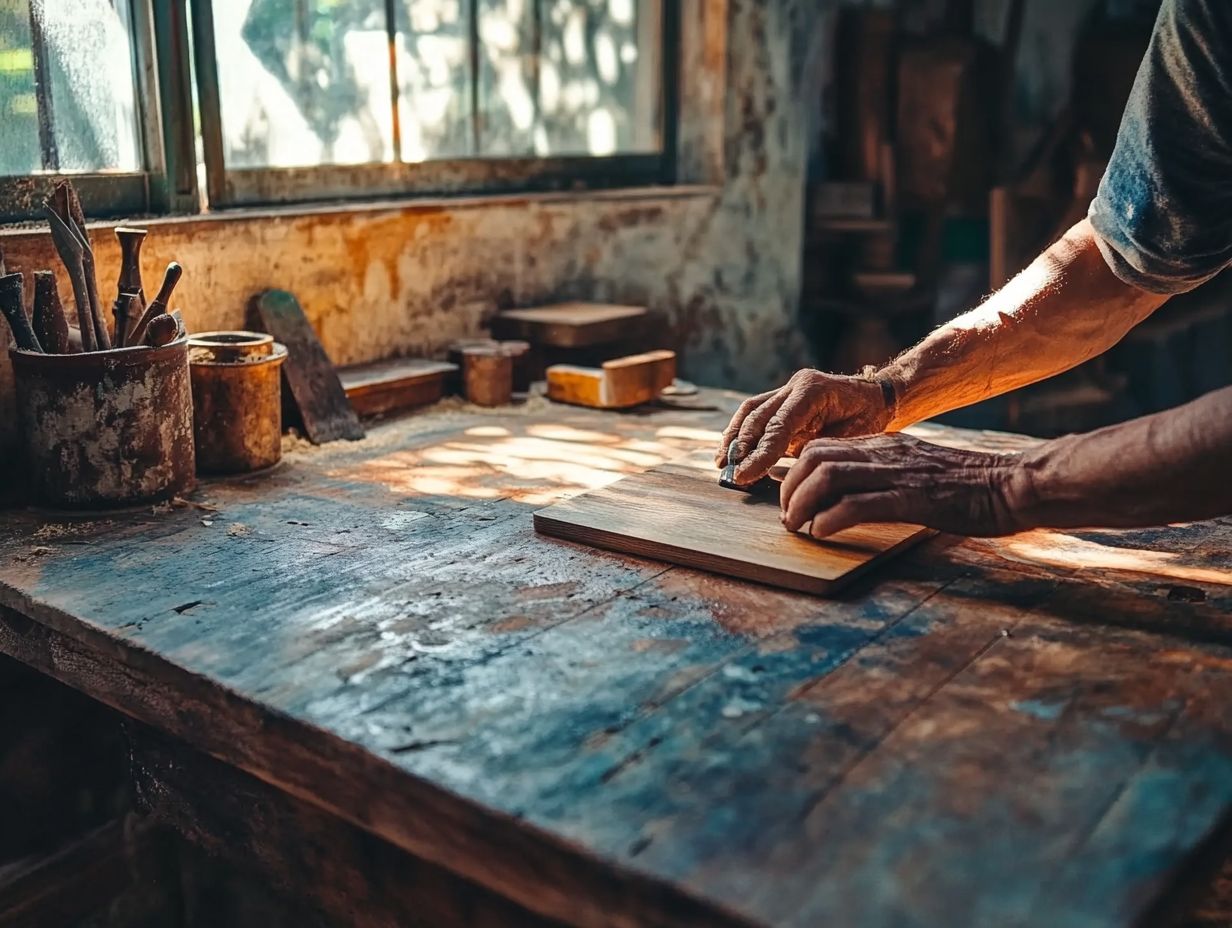
What types of techniques are needed to restore antique wood?
There are various techniques to restore vintage wood, including sanding, staining, and refinishing. Each technique serves a purpose and can bring new life to old wood pieces.
Is sanding necessary when restoring vintage wood?
Sanding is often essential in the restoration process. It helps remove surface imperfections like scratches or dents, creating a smooth and even base for any additional treatments or finishes.
Can I use any type of stain when restoring vintage wood?
It s important to use a stain specifically designed for wood when restoring vintage pieces. Using the wrong type can lead to an uneven or undesirable finish. Always test the stain on a small, inconspicuous area before applying it to the entire piece.
What is the best way to remove old paint or varnish from vintage wood?
Removing old paint or varnish from vintage wood can vary based on the finish and wood condition.
Consider methods like chemical strippers, heat guns, or sandpaper. Always research and follow instructions to protect the wood.
How do I know if a vintage wood piece is worth restoring?
Determining the worth of a vintage wood piece often depends on personal taste and sentimental value.
Key factors include its condition, rarity, and potential resale value. Evaluate these aspects to make your decision.
Can I restore vintage wood on my own or should I hire a professional?
Your skills and the restoration level needed will help you decide whether to DIY or hire a professional.
If you’re uncertain or lack the right tools, consulting with a professional can save you time and effort.

